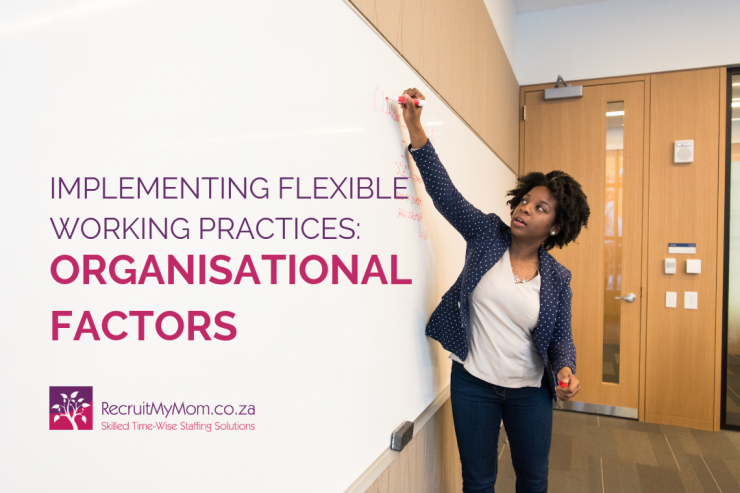
In the article “Important Factors when implementing Flexible work practices”, we focused on Individual preference such as work style, motivators and value systems and we shared some practical tools and advice on how these foundational and critical elements can be evaluated, measured and applied to increase the chances of success when implementing flexible work practices.
In this article, we focus on the organisational factors that play a role in flexible work. The organisational factors we are focussing on are technology, leadership and communication. It is proving to be the most difficult factors to understand, manage and change. The aim of the article is to not only acknowledge the challenges but more importantly, to share some advice and suggested strategies to address them.
The challenges associated with these organisational factors are largely due to the variety of factors included and the complexity and interrelatedness of all of them. This is also where the real change needs to take place and where, by default, the greatest resistance to the change will be experienced. Navigating this consciously and understanding that change in this area is a process, as opposed to an event or intervention, is of utmost importance.
In the article “Essential success elements to implementing flexible workplace arrangements” you can find a more comprehensive list of the factors falling under organisational factors. Here we will focus on the top three factors mentioned above, which in my view, are the ones which require principle alignment as part of the first steps in implementing flexible working practices.
Technology
In the past technological challenges were significant disablers to flexible work practices, yet today it is deemed the key enabler. It allows you to be more connected than ever before with access to information anywhere at any time. The vast amount of systems, programs and packages available is creating a new challenge though – one of being overwhelmed by choice which could easily leave one paralyzed. Information overload and the “always-on” culture has its own risks and challenges. These very realities which need to be acknowledged and managed. This is not only relevant in everyday life but very important in this context of implementing flexible work practices.
Technology is critical to the success of flexible working, yet it can also add an exceptional amount of unnecessary “noise” which could contribute or lead to project failure. When it comes to technology for flexible working, there are two considerations that I believe is useful to get conceptual clarity on:
1. Flexible working and technology are two distinctly separate things:
You are likely reading this and thinking I am stating the obvious and, in some way, I am, yet in practice, this logic is often overlooked. I have seen this happen in instances where a specific technology solution is selected to support flexible working arrangements and when the technology is found to be lacking, the conclusion is drawn that flexible working is impractical or impossible. Similarly, when technology is appropriately and effectively applied to enable flexible working, yet the boundaries or effective life management strategies are not properly implemented, flexible working is then blamed or it is concluded to be ineffective or unsustainable. In both instances, technology is at the root of the problem or concern and, acknowledging it as an enabler, which is separate from the goal (flexible working) itself, is essential to manage its impact.
2. Ownership of the technology decision:
Historically, IT owned all technology decisions and was responsible for supporting it with very little involvement from the rest of the business. When it comes to choosing appropriate solutions to support your flexible context’s work practices, I would strongly advise “getting your hands dirty” and being closely involved, if not leading the decision yourself. No one understands your unique needs as well as you do, and the good news is that there are plenty of free solutions which you can test and try out without incurring any financial costs. The benefits of these are that it will not only allow you to know exactly what is available and how to apply it, it will most likely also provide you with exciting new ideas of “what else is possible”. Review the article “12 Free Online Collaboration Tools For Virtual Teams” for some suggestions on excellent technology solutions.
In summary, if we acknowledge technology as the key enabler and manage it as such, we can focus on the other organizational factors, often referred to as “softer issues’, which is where the real challenge lies, and which will require a lot of focus and attention. The two most important of these elements, in my view, are Leadership and Communication.
Leadership
Leading flexible and remote teams are proving to be one of the most challenging changes which require both a change in mindset and then a whole new set of skills and leadership practices. As soon as the practical arrangement for flexible working is in place, the leader’s anxieties about their ability to manage and lead a team which they cannot “see”, emerges. A healthy part of this mindset change is to relinquish the false sense of control which managers normally have of “seeing my staff means I know what they are doing”. Differentiating leadership from management practices is another element which becomes very real as leaders of flexible workers are required to empower and create the ideal conditions for people to perform as opposed to controlling and monitoring their every activity. This is evident in a number of articles which are focused specifically on challenging these traditional leadership mindsets – If you can't trust your employees to work flexibly, why hire them in the first place? And Top 15 Tips To Effectively Manage Remote Employees.
The extent of the change and challenges associated with leadership varies significantly from organization to organization and between individual leaders. Leaders are required to first identify and unlearn less useful strategies and skills before acquiring new skills. In my experience and opinion, the most effective approach is to support each leader at an individual level through Leadership Coaching with a very specific focus on change in leadership style and practices and to adapt to the requirements of flexible working.
If you can support your leaders and enable them to succeed, the likelihood of overall success is multiplied. If on the other hand leaders don’t acknowledge the need to change their own leadership style, they are likely to contribute to the challenges that lie ahead. Therefore, investing in your leaders and enabling them to make the required shifts is, in my view, the most important and worthwhile investment you could make in both time and resources.
Communication
Communication is key to success in any relationship and consequently also in the employment relationship. Whilst a large portion of communication happens informally and organically in most office-based environments, it is not something we can afford to leave to chance to “settle on it's own” in flexible working contexts. The requirement for conscious and deliberate, focused communication about the right topic at the right time and at the right cadence, is essential. Many good suggestions have been documented and provide excellent advice on how to manage communication in flexible teams: How to Communicate & Engage with Remote Employees.
Taking a step back from the detail, I believe the most important aspect to establish about this topic is that communication is not something that is owned by the leader alone but by every single member of the team. The responsibility for the previous two topics (technology and leadership) is mainly the responsibility of the employer, whilst on this topic, I would argue, that the onus is on the employees to make a fundamental shift. Historically, employees expected communication to flow towards them and felt very little responsibility to communicate pro-actively from their side.
One of the biggest adjustments which employees who are already enjoying flexible working conditions testify to is the responsibility to communicate pro-actively. To make yourself known, to share what you are doing, to ask for what you need, to reach out to others, to check-in, to give status updates, to notify your team or leader when you are not able to deliver on time. In other words to make yourself noticeable when you are not visible. Out of sight, out of mind is a reality that flexible workers need to acknowledge, understand and own. Failure to take up this responsibility on the part of the employees have, time and time again, shown to derail the best designed and well supported flexible working practice projects.
Creating awareness amongst employees to understand their role in this and preparing them to take up the responsibility is a critical first step that should not only be addressed in the initial states but should be revisited throughout the change process by reflection and re-contracting amongst all team members.
Dreaming about and debating the benefits of flexible working are interesting, stimulating and energizing. Making the decision to implement it is likely to bring about a healthy level of nervous excitement. When the reality of the magnitude of the change settles in, it is important to get practical and honest about how hard it is likely going to be to change the mindsets and practices that have been part of our mental models of how “work works” for our entire lifetimes. Addressing these as part of your first steps will no doubt be a huge challenge. In my opinion and experience, however, it will save a lot of time and pain later in the process. Ensuring the three foundational organizational elements: Leadership as the guiding and empowering force, technology as the enabler, and communication as the glue that holds it all together, are all in place, will set the foundational scene for future flexible working success.
Author: Rentia Landman – Industrial Psychologist | Professional Coach | HR Consultant | OD Specialist and owner of Landman Consulting



